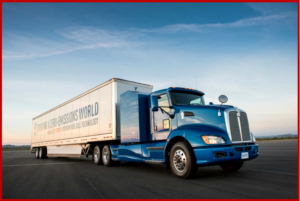 A Toyota feasibility study will assess the potential use of fuel cells in heavy-duty applications starting with the Port of Los Angeles. Announced at a press conference with Port and employees from the California Air Resources Board (CARB) and the California Energy Commission (CEC), the zero-emission truck is billed as a proof of concept that will take part in an experiment about the potential of fuel cells in large trucks.
A Toyota feasibility study will assess the potential use of fuel cells in heavy-duty applications starting with the Port of Los Angeles. Announced at a press conference with Port and employees from the California Air Resources Board (CARB) and the California Energy Commission (CEC), the zero-emission truck is billed as a proof of concept that will take part in an experiment about the potential of fuel cells in large trucks.
The study will begin this summer and possibly contribute to the Port’s Clean Air Action Plan, which has reduced some harmful emissions from operations at the Ports of Long Beach and Los Angeles since its inception in 2005.
“As they did with the Prius and the Mirai, Toyota is taking a leap into the future of technology by bringing this heavy duty, zero emission hydrogen fuel cell proof of concept truck to the Port. Toyota has planted a flag that we hope many others will follow,” said Mary D. Nichols, Chair, California Air Resources Board (CARB).
Toyota claims that the so-called Project Portal is the next step in its effort to broaden the application of zero-emission fuel cells (that depends on how you produce the hydrogen – editor) that can serve a range of industries. It is a fully functioning heavy duty truck with the power and torque capacity to conduct port operations while emitting nothing but water vapor. Heavy duty vehicles make up a significant percentage of the annual emissions output at the Port of Los Angeles, and the Portal feasibility study may provide a way to reduce emissions.
“Toyota believes that hydrogen fuel cell technology has tremendous potential to become the powertrain of the future,” said TMNA Executive Vice President Bob Carter. “From creating one of the world’s first mass market fuel cell vehicles, to introducing fuel cell buses in Japan, Toyota is a leader in expanding the use of versatile and scalable zero-emission technology. With Project Portal, we’re proud to help explore the societal benefits of a true zero emission heavy-duty truck platform.”
The Project Portal platform is designed to provide the target performance required to support port drayage operations. The truck generates more than 670 horsepower and 1325 pound feet of torque from two Mirai fuel cell stacks and a 12kWh battery, in what appears to be a small battery to support class 8 loads. The concept’s gross combined weight capacity is 80,000 pounds and its estimated driving range is more than 200 miles, under normal operation.
“The Port of Los Angeles is excited to collaborate with Toyota to explore the feasibility of fuel cell technology for port drayage operations,” said Tony Gioiello, Deputy Executive Director of Port Development, Port of Los Angeles. “Our port and industry stakeholders have demonstrated their leadership in reducing pollution from port-related operations, and we see the potential of Toyota’s zero-emission heavy-duty truck technology as another solution to meet the long-term goals of the San Pedro Bay Ports Clean Air Action Plan.”


Well I guess if James Bond can make a movie about the evil guys living in a fuel cell powered desert hideout it was only a matter of time…:)